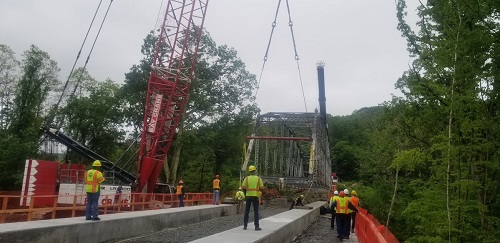Town Bridge, Canton CT By Sphilbrick - Own work, CC BY-SA 3.0, https://commons.wikimedia.org/w/index.php?curid=26395077
The Town Bridge in Canton, Connecticut, was the subject of an impressive bridge move last month. The bridge is an historic truss that was constructed in 1895. It crosses the Farmington River on a 160’ span. The fabricator was the Berlin Bridge company, known for lenticular truss bridges around New England. The structure is a Parker Through truss, one of the few the company fabricated. It is also unusual because the superstructure features many decorative details that the company typically included on lenticular truss bridges.
The rehabilitation design, prepared by Transystems, called for extensive reconstruction of the superstructure. The truss was to be removed from its bearings, disassembled, repaired off site, and then rebuilt on site.
ROTHA Contracting Company, Inc, of Avon, Connecticut, completed the complex operation to lift the superstructure onto temporary bearings on the east shore of the river. A video of the operation is here.

Town Bridge Move - Town of Canton CT/ ROTHA
Russell Bush, from Rotha, described the operation:
The bridge is a notable historic structure based on the environmental review and documentation. Did this pose any special concerns for your means and methods?
Russell Bush: Being a historic structure posed a number of concerns. First and foremost, the bridge had undergone multiple rehabilitations over its 125 life span. This made weight estimations very difficult because there wasn’t precise documentation of all of the repairs. Additionally, the unknown grade of the old steel gave us challenges when we had to install welded stiffeners to brace the structure for the pick.
The last inspection report noted that the condition of the superstructure was “3: serious condition”. Did this impact means and methods for the truss move- what type of reinforcement did you need to do before the move?
Russell Bush: Multiple layers of paint as well as the limited access we had to inspect the structure also made our checks of structural integrity of the structure difficult…we knew it was in poor condition but determining the exact extent was challenging. We inspected every member and connection to the best of our ability as we removed the deck. Additionally, we installed welded stiffeners at the pick points to reinforce the structure for the lift.
Were there any special concerns/ procedures for the truss move, especially for the crane on the far bank that had the extended boom?
Russell Bush: Engineering the pick itself took multiple weeks and iterations. We had specific restrictions on the amount of ground pressure we were allowed to induce into the existing substructures which forced us to get creative with the construction of our crane pads and also pushed our pick radius’s out about as far as they could go. The more capacity we tried to squeeze out of the cranes by adding special boom sections or more counter weight was counter balanced by forcing us to push the cranes further away to reduce ground pressure. Through a collaborative effort between our engineers and Bay Crane we found the happy medium that facilitated the successful pick without over loading the existing substructure.
How did the jacking go before the truss move? What jacks did you use?
Russell Bush: Before the pick we used a Power Team jack to make sure each bearing was free from the substructure. We also used the jacks to double check our weight estimates for the structure.
Is it planned to galvanize the truss superstructure offsite?
Russell Bush: After we picked up the truss and set it on our preconstructed access pad, we dismantled and tagged every piece. We loaded out the individual pieces and shipped them to Regal Industrial Corp in PA for blast cleaning. From there, the pieces are being sent to Michelman Steel Enterprises, LLC, also in PA, where they will be reassemble, repaired and reinforced. Once all the repair work is completed, the truss pieces will be shipped to galvanizing and then back to us for reassembly on the site.
Watching the video of the move, you get to see an impressive combination of the old and the new. When the job is done, the beautiful, historic truss bridge will live again to grace its site as a working structure. To get there, the rehabilitation project employed a spectacular lift.


Post a comment to this article
Report Abusive Comment